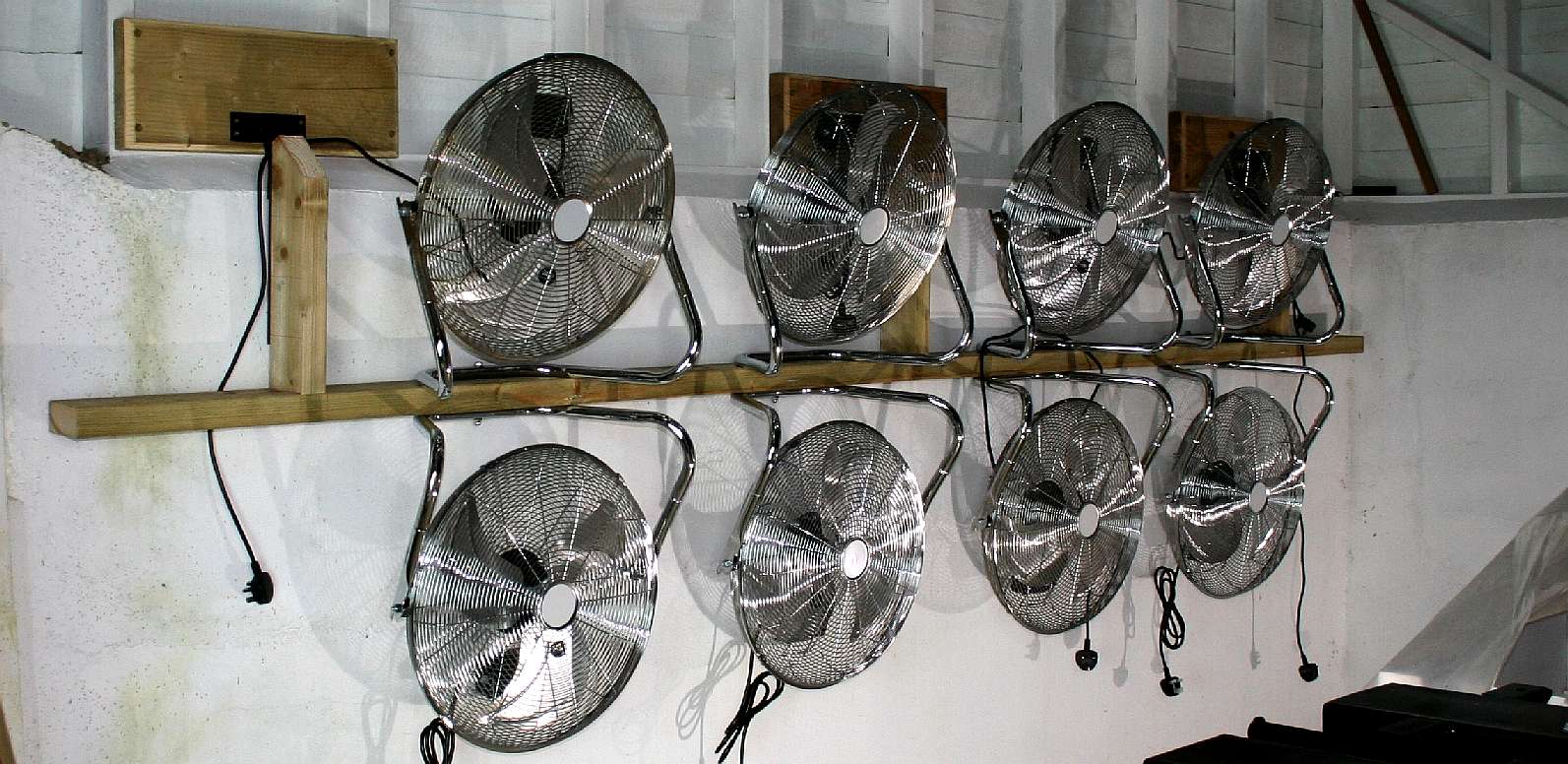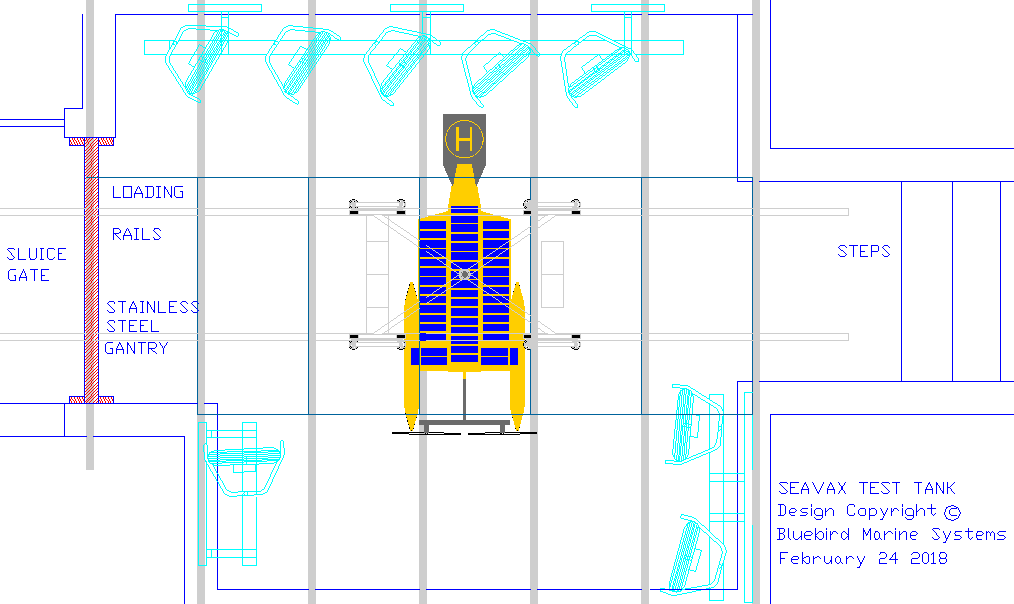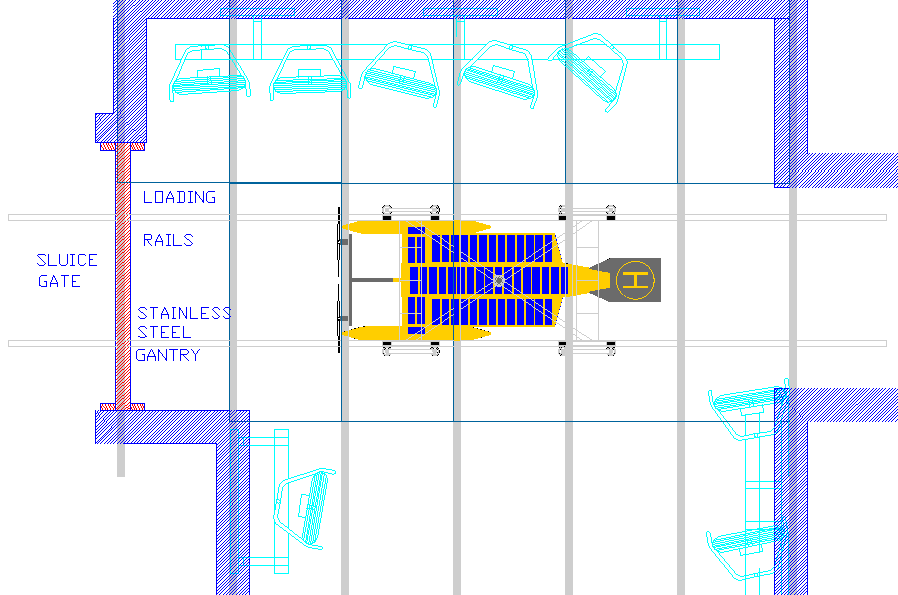|
SEAVAX - WIND MAKING MACHINES
BRICKWORK - CARRIAGE - DRAINAGE - FACILITIES - FILTRATION - GLASS & PAINT - GANTRY - GIMBALS - HATCHES HYDRODYNAMICS HISTORY - INSTRUMENTS - LABORATORY - LAMINATING - LOGISTICS - OUR TEST TANK - PROOFING - REVIEWS - SCREED SEAVAX TEST VIDEOS - SLUICE GATE - SOLAR BATTERIES - WAVE MAKING - WIND MACHINE
|
||
|
DIRECTION - The fans can be tilted up away from the wall as a bank - all the way to the beams above for net storage when not in use. Each individual fan can also be revolved and tilted separately to the others. By this means we can create a revolving storm in the test tank with the appropriate guides. Copyright © photograph February 23 2018. All rights reserved. You will need the permission of the Cleaner Ocean Foundation to reproduce these pictures except for educational use or private research.
It will take us a bit longer, but we will be fitting wind making machines inside our test tank, to be able to create storm and even hurricane conditions for our SeaVax testing program. Eight industrial, high-velocity fans (seen below) from China were purchased (17-6-16) at a total cost of £240, with a further ten slightly higher specification units added this year at a cost of £410 (8-3-18), to give us 18 fans for deployment in our test tank.
POWER OUTPUT - FLOW RATE
Collectively, even in standard form these units are rated as supplied to provide 2.97 horsepower (2,220w) of power @ 1,350rpm and around 70,315 CFM (1,990 m3/min) of air movement.
That is 33.18 cubic meters of air per second (1,171 cubic feet of air per second) in a sealed tank with an internal airspace volume of around 50 cubic meters. Hence, the air in the chamber will rotate completely every 1.7 seconds, simulating as close to a 100- 150mph revolving storm in 1/20th scale as we can realistically achieve on our present budget. The challenge will be to configure our fans for rear, side and head on winds, and to change configuration for a revolving storm. The fans offer various speeds that may be fine tuned with a little electronic wizardry.
The performance of our fans may be improved (we doubt if necessary) by changing the triple-bladed pressed aluminium fan blades for twin-bladed wooden or composite model aircraft propellers - that are far more efficient, but this is likely to require faster spinning motors or very high pitch props.
WIRING
As of March 2018, all but two fans have been mounted in the test tank on wooden frames that can be folded up and out of the way of other experiments when not needed.
The wiring of these units has to be waterproof, using the appropriate connectors.
MULTIPLE FAN BANKS - Looking a little cluttered with no water in the tank and still a lot of building bits and bobs to complete in the passage to the robot lab, but the fans are in and just need wiring up. Unfortunately not evenly matched, it is though still possible to generate a number of high wind conditions, including a tropical revolving storm - with sixteen fan units as per the picture above. Copyright © photograph March 6 2018. All rights reserved. You will need the permission of the Cleaner Ocean Foundation to reproduce these pictures except for educational use or private research.
YOUNG SCIENTIST - Our youngest team member, Ryan, is seen here sampling the country air in accelerated quantities. Copyright © photograph March 10 2018. All rights reserved. You will need the permission of the Cleaner Ocean Foundation to reproduce these pictures except for educational use or private research.
DIRECTION - In this picture we see the fans aimed to produce a confused vortex. At the moment the absence of screens and guides is reducing the efficiency of the test tank unit. Copyright © photograph March 10 2018. All rights reserved. You will need the permission of the Cleaner Ocean Foundation to reproduce these pictures except for educational use or private research.
WHY BOTHER ?
SeaVax is solar and wind powered. Our solar wings track the sun and so move a large flat panel surface upwards into prevailing winds. This panel acts like a crude sail, and this in turn will affect the heel of the vessel at some compass headings. We need to know what the heel effects will be on the hull as it affects stability.
The same applies to our wind turbines. When they are hoisted in high winds the vessel will heel in proportion to the wind speed. We need to measure the heel to find the safe parameters for our robot engineers to be able to program SeaVax to furl the turbines when conditions are deemed to be hostile.
INDUSTRIAL FANS - Made of steel and chrome plated, the guard of these fans is 20" inches in diameter, the blade is aluminium. We will be able to pan and tilt these fans to aim them to create authentic storm conditions.
Aircraft propellers are designated by two numbers: Diameter and Pitch. Thus an 18-6 propeller is 18" in diameter and has 6" of pitch. Pitch is the distance a propeller will move forward in one revolution in a perfect fluid (which air is not).
You can imagine this as a screw in wood. The pitch determines how far the screw will penetrate the wood for each revolution of the screw-driver. Thus, a 6" pitch will move forward 6" with each 360° revolution of the propeller. If you multiply the swept area by the pitch, by the number of revolutions per minute, by the efficiency - this will give you the theoretical movement of air - hence, the ability to calculate thrust, where air density (ρ) = 1.225 kilograms per cubic meter. We are ignoring slip (and in the case of a water propeller, cavitation) and other related issues in this example.
For our setup, available thrust should be in the region of 116lbs using aircraft profile propellers. We will be providing more information on this as our experiments take place.
LINKS & REFERENCE
http://www.airfieldmodels.com/information_source/math_and_science_of_model_aircraft/formulas/index.htm#propeller_efficiency https://avaaz.org/
BRICKWORK - CARRIAGE - DRAINAGE - FACILITIES - FILTRATION - GLASS & PAINT - GANTRY - GIMBALS - HATCHES HYDRODYNAMICS HISTORY - INSTRUMENTS - LABORATORY - LAMINATING - LOGISTICS - OUR TEST TANK - PROOFING - REVIEWS - SCREED SEAVAX TEST VIDEOS - SLUICE GATE - SOLAR BATTERIES - WAVE MAKING - WIND MACHINE
|
||
|
This page is Copyright © 2018 Bluebird Marine Systems Ltd. The names AmphiMax™, Bluebird™, Bluefish™, Miss Ocean™, RiverVax™, SeaNet, SeaVax™, and the blue bird & fish in flight logos are trademarks. All other trademarks are hereby acknowledged.
|







